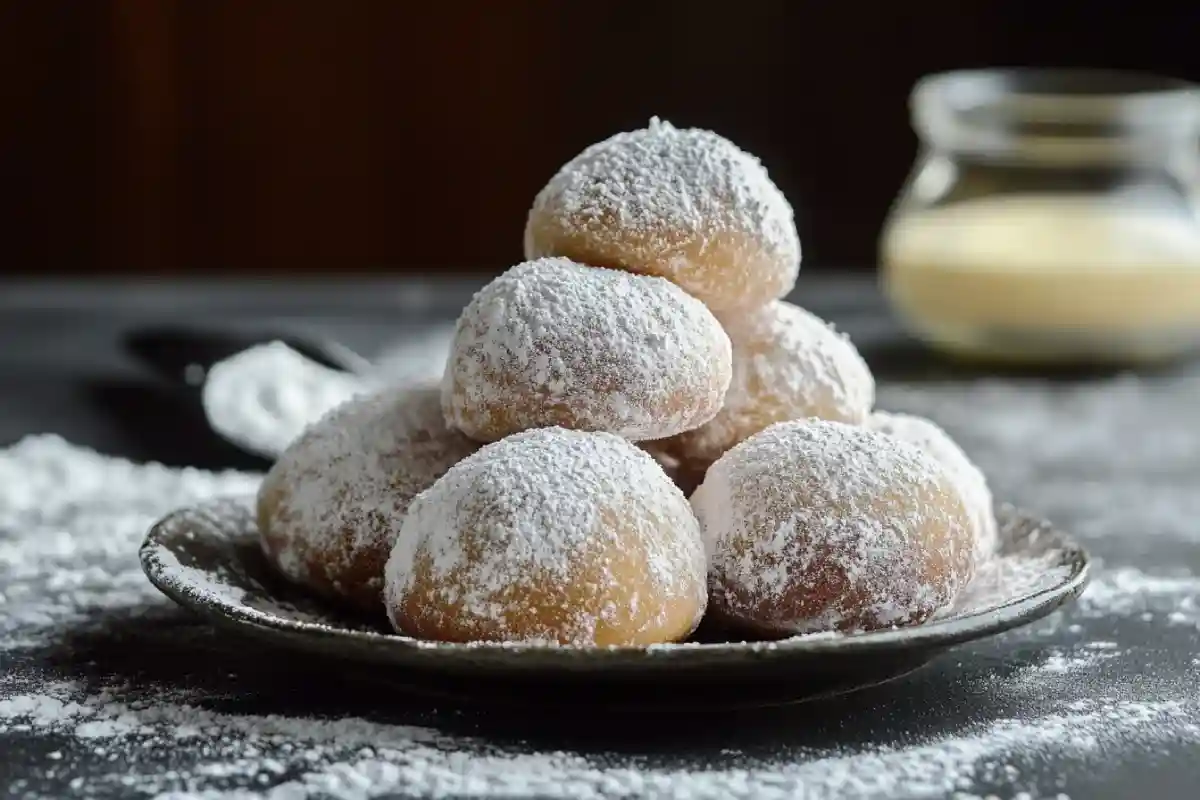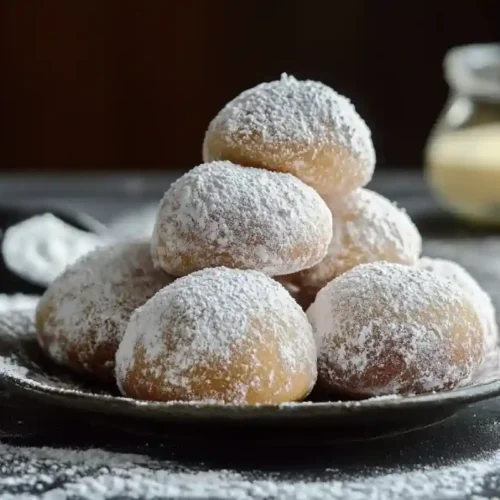
Table of Contents
These classic French beignets start with a light, yeasted dough enriched with butter and a splash of vanilla, then fry to airy squares that vanish under a snowfall of powdered sugar. After three test batches I nailed a 60-minute rise and 350 °F oil temp that guarantee hollow interiors and a tender, melt-in-your-mouth crumb every time.
What Are Beignets?
When diving into any french beignets recipe, it’s essential to understand what beignets truly are. These iconic pastries trace their roots back to France, where they have long been enjoyed as a staple dessert or morning treat. The word “beignet” itself translates to “fritter” in French, and it perfectly describes this light, deep-fried dough that’s typically coated with powdered sugar.
Historically, beignets were introduced to Louisiana by French settlers. Over time, they evolved and became synonymous with New Orleans cuisine. Although variations exist globally, the authentic french beignets remain a timeless classic, especially when crafted with care.
Today, beignets come in many forms—from filled to glazed to baked—but the classic version is still the most beloved. Made with a yeasted dough, these treats puff up beautifully when fried. The interior stays soft and airy, while the outer layer becomes golden and slightly crisp.
Key Characteristics of Authentic French Beignets:
- Square or round shape, traditionally cut from risen dough
- Light and airy texture achieved through yeast-based fermentation
- Powdered sugar coating added immediately after frying
- Commonly served warm with coffee or tea
Interestingly, their texture is largely influenced by how the dough is developed. Creating the right gluten structure is crucial for achieving a soft and stretchy dough. For a detailed look at how gluten affects pastry texture, The Science of Gluten in Bread offers helpful, non-commercial insights.
Additionally, if you’re exploring other New Orleans-inspired foods, this Louisiana Dishes Recipe Guide provides inspiration and can complement your french beignets recipe perfectly.
Whether you’re new to French pastries or already a fan, understanding beignets sets the foundation for baking them successfully at home. And with that knowledge, you’re ready to explore the essential ingredients that make these pastries unforgettable.
Ingredients Needed for a Traditional French Beignets Recipe
To make a truly memorable french beignets recipe, the ingredients you use matter more than you might think. While it’s tempting to swap out components for convenience, using authentic items ensures both the texture and flavor remain spot on. Moreover, even slight changes can affect how the dough rises, fries, or holds its shape.
Fortunately, the ingredient list is short and sweet. Still, each plays a crucial role. As you read on, you’ll see how each contributes to creating those pillowy, golden pastries we all love. Before you begin, take a moment to review everything you’ll need. After all, preparation is the first step to success in baking.
Essential Ingredients:
- All-purpose flour – Forms the base of the dough and provides structure.
- Active dry yeast – Essential for creating a light and airy texture.
- Warm water or milk – Helps activate the yeast and moisten the dough.
- Granulated sugar – Adds sweetness and also helps with yeast activation.
- Salt – Enhances flavor and supports gluten development.
- Eggs – Enrich the dough and contribute to tenderness.
- Butter – Adds flavor and softness, creating a smooth, pliable dough.
- Powdered sugar – Essential for dusting and finishing the final beignets.
Each of these ingredients works in harmony. Therefore, skipping or replacing one might drastically change your outcome. Additionally, understanding how gluten affects texture can elevate your baking. For a practical look into this process, King Arthur’s guide to flour and structure offers helpful insight without being a direct competitor.
For more creative spins on French-inspired desserts, check out Flavivo’s take on baked beignets—a lighter twist for those who prefer oven-baked options.
Together, these ingredients form the base of your perfect french beignets recipe, ensuring every bite delivers that classic, authentic taste.
Step-by-Step Instructions: How to Make Authentic French Beignets
Once all your ingredients are ready, it’s time to move from preparation to action. This section of the french beignets recipe outlines every step you need to follow to achieve soft, airy beignets with a delicate golden crust. Although the process involves several stages, each one builds upon the last to deliver authentic results. Moreover, by understanding the why behind each action, you’ll gain the confidence to perfect this classic pastry over time.
Step-by-Step Process
1. Prepare the Dough
- Start by dissolving active dry yeast in a bowl of warm water or milk.
- Stir in sugar and allow the yeast to activate for 5–10 minutes, forming a frothy surface.
- Mix in eggs, melted butter, and salt.
- Gradually add flour while mixing until a smooth, sticky dough forms.
2. Knead and Let It Rise
- Transfer the dough onto a floured surface and knead for 8 minutes until elastic.
- Place it into a lightly oiled bowl, cover, and let it rest in a warm spot for 1–2 hours.
- During this time, the dough should double in volume.
3. Roll and Cut
- After the dough has risen, gently deflate it and roll it out to a ¼ inch thickness.
- Cut the dough into even squares using a knife or pizza cutter.
4. Fry Until Golden
- Heat oil in a deep pan to 360°F (182°C).
- Fry a few beignets at a time until both sides are golden brown.
- Remove and drain on paper towels.
5. Dust and Enjoy
- While still warm, dust generously with powdered sugar.
- Serve immediately for the best taste and texture.
Quick Reference Table
| Step | Estimated Time | Key Tip |
|---|---|---|
| Dough Preparation | 20 minutes | Make sure the yeast is fully activated |
| Dough Rising | 60–120 minutes | Let it rise in a warm, draft-free place |
| Rolling and Cutting | 10 minutes | Keep dough even for uniform frying |
| Frying | 5–7 minutes | Maintain oil temperature for consistent color |
| Sugar Dusting | 5 minutes | Apply sugar while beignets are still warm |
For another unique dessert experience, consider trying this sweet take on cannoli snacks with Cannoli Chips & Dessert Tips. It’s a playful twist that pairs perfectly alongside your french beignets recipe when entertaining.
Altogether, this methodical approach makes the french beignets recipe approachable for beginners while still satisfying seasoned home bakers. By following each step carefully and understanding its purpose, you’ll master the art of making these beloved French pastries.
Tips and Tricks for Perfect Beignets Every Time
Even if you follow the french beignets recipe exactly, small adjustments can make a big difference in the final result. Mastering a few pro tips ensures that your beignets come out consistently light, airy, and golden—not too greasy, not too dense. These tricks are especially helpful for beginners, but even seasoned home cooks will benefit from the added precision they bring.
Moreover, since frying is such a key component of this recipe, understanding how heat, oil, and dough interact will help you avoid common pitfalls. With that in mind, let’s explore a few practical ways to elevate your homemade beignets.
Top Tips for Success
- Use a kitchen thermometer
Always monitor your oil temperature. Keeping it steady at 360°F (182°C) ensures the beignets cook evenly without absorbing too much oil. - Avoid over-flouring your surface
While a floured work surface helps prevent sticking, using too much flour can toughen the dough. - Do not crowd the fryer
Fry only a few beignets at a time. This keeps the oil temperature stable and allows for even browning. - Flip at the right time
Wait until the bottom turns golden before flipping—usually around 45 seconds in. - Dust with powdered sugar while warm
This helps the sugar stick better and enhances the flavor immediately after frying.
Troubleshooting Table
| Issue | Likely Cause | Quick Fix |
|---|---|---|
| Beignets too greasy | Oil too cool | Heat oil to proper temp before frying |
| Flat or dense beignets | Underproofed or overworked dough | Let dough rise fully and handle it gently |
| Uneven browning | Inconsistent oil temperature | Fry fewer at a time and monitor heat closely |
For more Southern-inspired desserts with rich flavor and nostalgic charm, you might enjoy Flavivo’s recipe for Delicious Cornflake Candy. It’s an excellent complement to your french beignets recipe, especially when serving a dessert platter.
By applying these simple yet effective tips, you’ll elevate your beignets from homemade to professional quality. Most importantly, these tricks turn your kitchen into a Parisian café, one perfect bite at a time.
Frequently Asked Questions
What is the secret to making beignets?
The secret lies in achieving the right dough texture and maintaining consistent oil temperature. A well-proofed, slightly sticky dough creates a light and airy center, while frying at 360°F gives them a perfect golden finish. Timing, too, matters—letting the dough rise fully and not over-handling it makes all the difference in this french beignets recipe.
What are beignets in France?
In France, beignets are traditional deep-fried pastries often filled with fruit preserves or simply dusted with powdered sugar. While similar in look to doughnuts, they’re lighter and more delicate. They’re commonly enjoyed during celebrations like Mardi Gras, and an authentic french beignets recipe focuses on soft texture and rich flavor, without heavy toppings or glazes.
What is the difference between a beignet and a Berliner?
Although both are fried pastries, a beignet is typically square and served without filling, especially in the french beignets recipe tradition. On the other hand, a Berliner, popular in Germany, is round and usually filled with jam or custard. The doughs differ slightly too, with Berliners often being a bit sweeter and denser.
What’s the difference between beignets and bomboloni?
Beignets and bomboloni are both fried pastries, yet they have unique traits. Beignets, especially those from a french beignets recipe, are airy and square, commonly served with powdered sugar. Bomboloni, an Italian treat, are round, often filled with pastry cream, and more cake-like in texture. The serving styles and fillings clearly set them apart.
Conclusion
In the end, few things are as comforting and satisfying as freshly made beignets. This french beignets recipe brings together tradition, simplicity, and indulgence in every bite. Whether you’re creating a brunch spread for friends or treating yourself to a quiet morning pastry, the joy of making something so classic from scratch is unmatched.
Moreover, because the ingredients are so basic and the process so approachable, this recipe easily becomes a household favorite. Once you’ve mastered the technique, you can endlessly customize it with your own personal touches. From pairing them with coffee to serving them alongside fruit compote, these beignets adapt beautifully to any occasion.
Most importantly, preparing them at home lets you enjoy the authentic french beignets experience without needing a café on the corner. The light, golden crust and delicate inside make them a timeless treat worth sharing again and again.
So, the next time you’re in the mood for something sweet, warm, and truly special, return to this french beignets recipe—because the charm of French baking is always just a few ingredients away.

Authentic French Beignets Recipe
Ingredients
- ¼ tsp Active dry yeast Make sure it’s fresh
- 1 cup Warm water About 110°F 43°C
- ¼ cup Granulated sugar Helps activate yeast
- 2 tbsp Unsalted butter Melted
- ½ tsp Salt Enhances flavor
- 1 Egg Beaten
- ½ cup Whole milk Warmed
- 3 ½ cups All-purpose flour Sifted
- For dusting Powdered sugar Use generously after frying
- For frying Vegetable oil Canola or sunflower recommended
Instructions
- In a large bowl, dissolve yeast in warm water. Add sugar and let sit for 5–10 minutes until foamy.
- Mix in melted butter, salt, egg, and milk. Gradually stir in flour until a sticky dough forms.
- Transfer dough to a floured surface. Knead for 8 minutes until smooth and elastic.
- Place dough in an oiled bowl, cover, and let rise for 1–2 hours until doubled in size.
- Roll out dough to ¼ inch thick. Cut into 2-inch squares.
- Heat oil in a deep pan to 360°F (182°C). Fry beignets in batches for 1–2 minutes per side, until golden brown.
- Remove and drain on paper towels.
- Dust with powdered sugar while still warm and serve immediately.
Notes
- Make sure your yeast is active for the best rise. If it doesn’t foam in the first step, start over.
- Beignets are best served warm and fresh but can be stored in an airtight container and reheated briefly in the oven.
- For flavor variation, consider adding a dash of vanilla extract or cinnamon to the dough.
